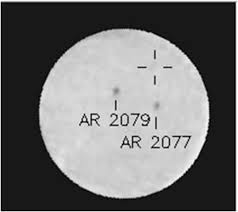
 The “Man in the Moon” appeared when meteoroids struck the Earth-facing side of the Moon, creating large flat seas of basalt that we see as dark areas called maria. But no “face” exists on the far side of the Moon and now, Penn State astrophysicists think they know why.
The “Man in the Moon” appeared when meteoroids struck the Earth-facing side of the Moon, creating large flat seas of basalt that we see as dark areas called maria. But no “face” exists on the far side of the Moon and now, Penn State astrophysicists think they know why.
“I remember the first time I saw a globe of the Moon as a boy, being struck by how different the far side looks,” said Jason Wright, assistant professor of astrophysics. “It was all mountains and craters. Where were the maria? It turns out it’s been a mystery since the fifties.”
This mystery is called the Lunar Far-Side Highlands Problem and dates back to 1959, when the Soviet spacecraft Luna 3 transmitted the first images of the far side of the Moon back to Earth. Researchers immediately noticed that fewer “seas” or maria existed on this portion of the Moon that always faces away from Earth.
Wright, Steinn Sigurdsson, professor of astrophysics, and Arpita Roy, graduate student in astronomy and astrophysics and lead author of the study, realized that the absence of maria, which is due to a difference in crustal thickness between the side of the Moon we see and the hidden side, is a consequence of how the Moon originally formed.
The general consensus on the Moon’s origin is that it probably formed shortly after the Earth and was the result of a Mars-sized object hitting Earth with a glancing, but devastating impact. This Giant Impact Hypothesis suggests that the outer layers of the Earth and the object were flung into space and eventually formed the Moon.
“Shortly after the giant impact, the Earth and the Moon were very hot,” said Sigurdsson. The Earth and the impact object did not just melt; parts of them vaporized, creating a disk of rock, magma and vapor around the Earth.
“The Moon and Earth loomed large in each other’s skies when they formed,” said Roy.
The Moon was 10 to 20 times closer to Earth than it is now, and the researchers found that it quickly assumed a tidally locked position with the rotation time of the Moon equal to the orbital period of the Moon around the Earth. The same real estate on the Moon has probably always faced the Earth ever since. Tidal locking is a product of the gravity of both objects.
The Moon, being much smaller than Earth, cooled more quickly. Because the Earth and the Moon were tidally locked from the beginning, the still hot Earth—more than 2500 degrees Celsius—radiated towards the near side of the Moon. The far side, away from the boiling Earth, slowly cooled, while the Earth-facing side was kept molten, creating a temperature gradient between the two halves.
This gradient was important for crustal formation on the Moon. The Moon’s crust has high concentrations of aluminum and calcium, elements that are very hard to vaporize.
“When rock vapor starts to cool, the very first elements that snow out are aluminum and calcium,” said Sigurdsson.
Aluminum and calcium would have preferentially condensed in the atmosphere of the cold side of the Moon because the nearside was still too hot. Thousands to millions of years later, these elements combined with silicates in the Moon’s mantle to form plagioclase feldspars, which eventually moved to the surface and formed the Moon’s crust, said Roy. The farside crust had more of these minerals and is thicker.
The Moon has now completely cooled and is not molten below the surface. Earlier in its history, large meteoroids struck the nearside of the Moon and punched through the crust, releasing the vast lakes of basaltic lava that formed the nearside maria that make up the “Man in the Moon.” When meteoroids struck the far side of the Moon, in most cases the crust was too thick and no magmatic basalt welled up.
*******
MERCURY PASSES IN FRONT OF THE SUN, AS SEEN FROM MARS. NASA’s Curiosity Mars rover has  imaged the planet Mercury passing in front of the Sun, visible as a faint darkening that moves across the face of the Sun. The observations were made on June 3, 2014, from Curiosity’s position inside Gale Crater on Mars.
imaged the planet Mercury passing in front of the Sun, visible as a faint darkening that moves across the face of the Sun. The observations were made on June 3, 2014, from Curiosity’s position inside Gale Crater on Mars.
This is the first transit of the Sun by a planet ever observed from any planet other than Earth, and also the first imaging of Mercury from Mars. The observation by the telephoto camera of Curiosity’s two-eyed Mast Camera instrument is available at www.jpl.nasa.gov/video/?id=1309


Be the first to comment